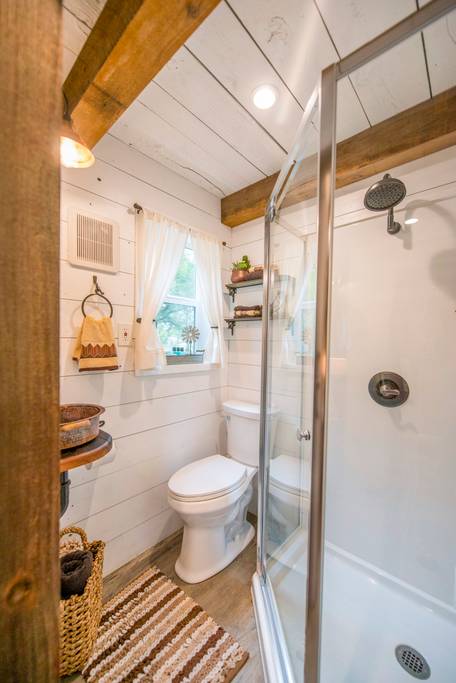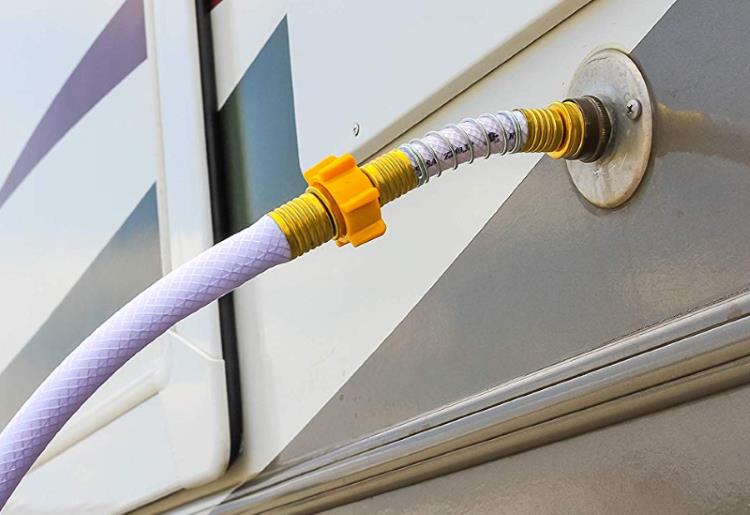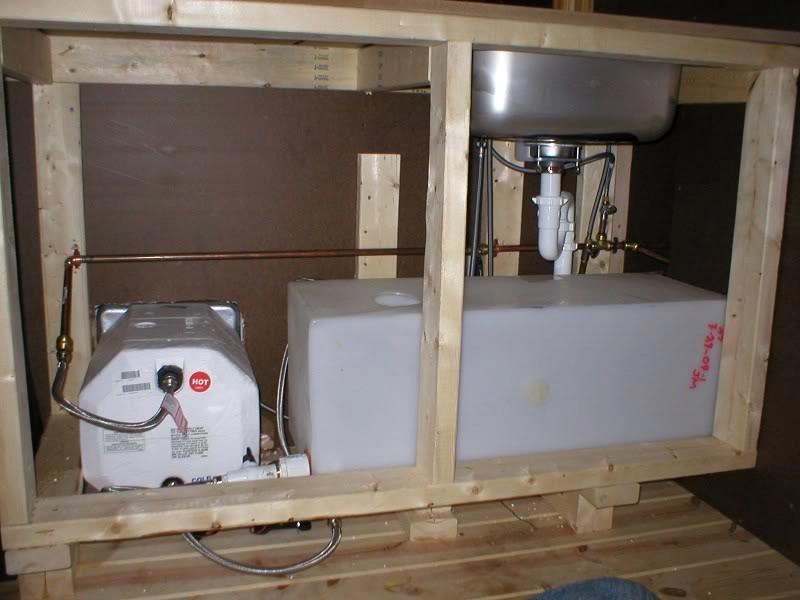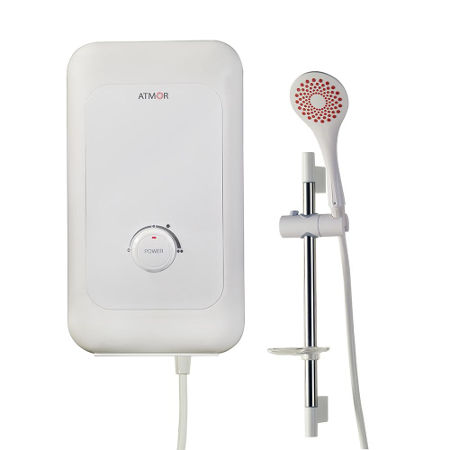Blog

How To Shower In A Tiny House
When planning out life in a tiny house, you’ll probably be thinking of whether your kitchen will be big enough or if you’ll hit your head all the time in your bedroom loft. But you probably won’t be thinking about how you will shower, and whether your shower will be powerful enough, despite this being a key point to consider. Hence we have written up this article which covers all that you need to know about tiny house showering.
If you are on-grid, you will have pressurized water suitable for showering delivered right to your door (well, wall)! But if you are off-grid, you will need to think much more carefully about how you get water suitable for showering and whether to pressurize the water with a pump.
Key Concepts
Before we dive into how to shower in a tiny house, it is worth going over some concepts you may or may not be familiar with already:
- On-grid. When your tiny house is parked in land which providers water (and drainage) facilities, or your tiny house is on a fixed foundation with access to water/drainage, you are on-grid. Getting a good, pressurized water supply to your tiny house will straightforward.
- Off-grid. Whenever your tiny house is based away from main infrastructure and hence you cannot simply ‘plugin’ to a water supply, you are considered off-grid. This can include parking your tiny house on a friend’s land which will provide ample space but no water/drainage hookups.
- Rainwater. Okay, we obviously all know what this is: it falls from the sky. Why am I including this here? Well rainwater is safe for showering with, and can actually be better than mains water because it will be softer water and contain less minerals which could irritate the skin. It can sometimes be used for drinking with, too, although some studies have shown that there are some potential health risks with this (hence disinfecting rainwater can be prudent).
- Fresh water. This refers to getting water from the mains water supply when on-grid. It is clean water which is treated and purified so that it is safe to drink (and certainly safe for showering).
- Soiled/black water. Water which has been soiled – usually waste water from toilets – is considered black water. This should be disposed of via the sewerage system when on-grid, and safely collected and disposed of when off-grid. Shower water is not considered black water but do check out our wider tiny house water guide to learn more about this.
- Waste/gray water. This is water which does not pose a health risk (like standing black water does), but it has been ‘used’ and mixed with things like wash detergent and shower soaps meaning that it is no longer safe for drinking. As you can probably guess, shower water falls under this category.
Water Sources When On Grid
Since ‘on-grid’ either refers to parking at an RV park or a piece of land within main infrastructure, the two main on-grid water sources are:
- RV-style water hose from external spigot/tap point. This will be the most common option for THOWs: when parked up on an RV site or campsite, water will be supplied via a ‘hole in the wall’ (water inlet fill valve) which you can plug into. This is similar to connecting a hose to an outdoor tap. Once hooked up, your entire tiny house’s plumbing will run off this water connection (meaning that all the interior plumbing will be the same as any other house):
 You can either run your shower directly from this, and have high pressure with little effort. However if you ever plan on taking your tiny house off the grid, it could be worth installing water storage tanks (which we explore in a future section). The water hookup will fill these, and your shower will then run off these. You can either add a pump to have a high-pressure shower (running from the main system water tank), or have a smaller water tank above the shower for gravity-fed showering which will be slower but not too slow.
You can either run your shower directly from this, and have high pressure with little effort. However if you ever plan on taking your tiny house off the grid, it could be worth installing water storage tanks (which we explore in a future section). The water hookup will fill these, and your shower will then run off these. You can either add a pump to have a high-pressure shower (running from the main system water tank), or have a smaller water tank above the shower for gravity-fed showering which will be slower but not too slow. - The option option is to hook-up to the main grid, like standard-size houses. This naturally will only make sense if you are planning on staying in the same spot for a long time, but it is ideal if your tiny house is on a foundation. Once you are hooked up to the mains, your showers will be high pressure and the supply should rarely be effected as it will be managed by the city water supplier.
Water Sources When Off Grid
If you are off-grid, you will not have a simple ‘hook up and go’ water supply to shower from. Storage tanks (which we explore in the next section) are important here, as you can fill them up once in a while and then freely shower without worrying about topping up the ‘shower water supply’ each time. Options here include:
- Use water containers to fill your water tank. This involves going to a clean water source every few weeks (which could potentially include a friend or neighbor’s outdoor tap) and filling up lots of water contains, then lugging them back to your tiny house in your car/van. From here, you can top up your water tank and shower easily until your supply runs out.
- Collect rainwater. Some people redirect water running down a roof’s guttering into rainwater collection tanks, which can then be used for showering. However a tiny house’s roof is fairly small, so some people install a separate rainwater catchment system which has a wider surface area. Whilst this is a good method for getting showering water, rainwater collection is illegal in some parts of America and other countries so be conscious of this before building a rain harvesting system.
- Spring or well water collection. Since you are off-grid, there is a good chance that there is a natural spring or even a well within a few miles. These are similar to option #1, allowing you to head there periodically and use the collected water to fill up your main water tanks for showering. Of course, ensuring that you are (a) allowed to tap into this supply and (b) that the water is clean/unpolluted is essential, even if you are only using it for showering and not drinking.
- Go old school: have no plumbing. With this approach, you decide that you do not want plumbing and water storage tanks taking up space in your tiny house. Instead, you can collect water from whichever source is most convenient and then place smaller water jugs and contains near any ‘washing locations’ (e.g. the kitchen and bathroom sinks). ‘Showering’ is then actually just ‘washing’ in true old school tradition. This approach saves money and frees up space around your tiny house (due to not needing pipework or big storage tanks), but it is very much a personal lifestyle decision.
Whether To Have Storage Tanks
We have mentioned storage tanks a few times already, but what exactly do we mean? Well unless you want to rely on always having a dedicated on-grid water supply, storing up water for using at a later date makes sense. This involves sacrificing around 2 kitchen cabinet’s worth of space for a big water tank and plubming/pumps:

The ‘outflow’ pipe (which would supply the shower) will usually be hooked up to an electric water pump to ensure a high pressure of water: a really slow shower is frustrating, which is where the pump helps.
A slightly different approach, however, is to have two water tanks: a smaller one in the kitchen, which would supply faucets and the washing machine, and then another one which sits on a shelf above the shower (perhaps in a sealed-off part of the loft area). Because this is above the shower, it can provide ‘gravity fed’ showering which has a decent flow rate and saves on the need for pumps. This can be hooked up to an electric shower which will reduce the plumbing complexity because you will just need a single cold water pipe going from the overhead tank to the shower.
Ensuring The Shower Has Pressurized (Fast) Water
No-one wants a shower with a slow flow rate: it will feel a bit frustrating, as though the water isn’t quite cleaning you properly (even though it obviously is). Whilst a slower flow rate can conserve water, this is probably a choice you want to make in the shower itself (by having a ‘water saving’ shower head) instead of being permanently restricted to slow showers due to limitations in your plumbing system. So what is the answer? Four ways to ensure you have quick-flowing shower water is:
- When on-grid, you will have quick flow rates from the direct water hookup. You just need to make sure that all parts of your internal plumbing use standard thickness pipework (since thinner pipes are sometimes used to help conserve water).
- Using an electric pump so that water from your water storage tank is delivered in a pressurized way to your shower.
- As mentioned earlier, having a water tank above your shower will lead to half-decent water pressure in your shower due to the effect of gravity. The tank should be 1m or more above the shower, however, to ensure that gravity leads to an acceptable level of water pressure.
- Tankless electric showers hook up just to a cold water pipe, reducing the complexity of your pipework and also potentially delivering a higher level of water pressure than a passive shower system. An example of this is the 6 kW Atmor system sold in Home Depot:

Drainage Options (Dealing With Shower Waste Water)
As you can probably guess by now, dealing with the waste water from your shower comes down to whether you are on-grid or off-grid!
- On-grid – RV park. RV parks and campsites which provide water hook-ups will usually provide a way of getting rid of that shower water, too – known as a full service hookup. This will take the form of a sewer opening which you can hook up with a dipped sewer hose (to provide a sewer vapor block). If only a partial service hookup is provided, you will need to dispose of waste separately – see some of the ‘off-grid’ options below.
- On-grid – main infrastructure. If you have a fixed tiny house location and tap into the city/town provided water supply, you should also have arranged (or been provided) access to the main sewer via a sewer/drainage point. You can connect up to this in the same way as a standard-size house.
- Off-grid – back to the ground. Shower water is classed as greywater, and hence this can often be dumped back into the ground in most areas (but do check your local zoning codes). To avoid a massive pool outside your tiny house, though, you will want to redirect this shower waste water towards grass/flowers, or build some sort of natural soakaway (such as a french drain) and disperse the greywater here.
- Off-grid – dump station. If you are unable to dump your shower water back to the ground, collecting this in sorted containers (one for greywater, one for blackwater) will allow you to take it to a registered dump station periodically. Some dump stations (also called ‘waste receiving stations’) are free for residential users, whilst others charge – so make some phone calls before travelling to your nearest one for the first time.
Photos And Videos Of Tiny House Showers
The gallery below (from our awesome tiny house roundup highlights some of our favorite tiny house showers:
https://www.youtube.com/watch?v=ohsY5NI_lXw&feature=emb_imp_woythttps://www.youtube.com/watch?t=20&v=B1Sz9bsBVK0&feature=emb_imp_woythttps://www.youtube.com/watch?t=346&v=8kZyMCk5cyE&feature=emb_imp_woyt